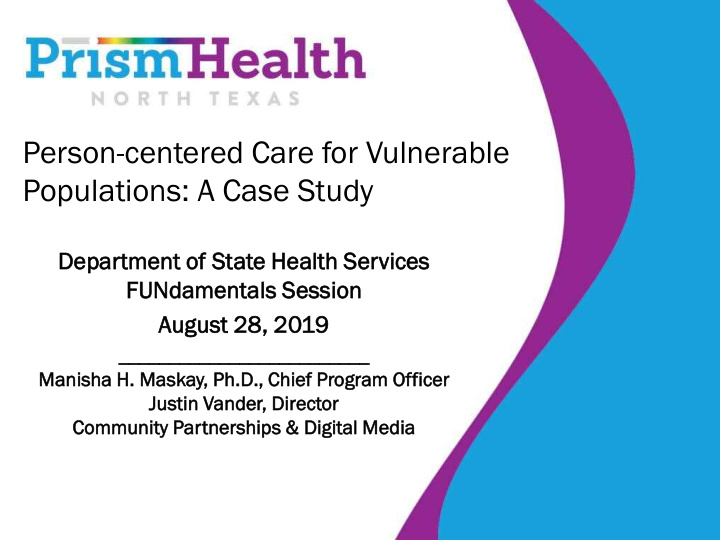



Person-centered Care for Vulnerable Populations: A Case Study Department o of State H Healt lth S h Servi vices FUNdame damental als S s Sessio ssion Augu gust 28, 28, 20 2019 _____ _____ ______ ______ ______ ______ ______ _____ __ Man Manisha H. H. Mas Maskay, Ph Ph.D., C Chief Pr Program Of Officer Justin Van ander, Dir irector Communit ity Par artnerships & & Digit ital al Me Media
Learning Objectives • Describe key components for developing and implementing models of care for vulnerable populations. • Identify at least two elements to improve individual client level outcomes. • Describe strategies to sustain critical program elements.
Case Study - a focus on PLWH with complex needs • PHNTX, one of 9 sites tasked with – Developing/implementing a model of care for people living with HIV (PLWH), co-diagnosed with mental health and/or substance misuse disorders, experiencing homelessness – Disseminating key development/implementation action steps and study findings through multiple platforms • Demonstration project/study supported by the Health Resources and Services Administration, HIV/AIDS Bureau, Special Projects of National Significance, 2012-2017.
Rationale
Prism Health North Texas formerly known as AIDS Arms, Inc. Mission Advancing the health of North Texas through education, research, prevention, and personalized integrated HIV care.
Prism Health North Texas • Provides integrated care and services: − Outreach to and testing for those at high risk for HIV/STIs − HIV/STI prevention and treatment - risk reduction, education and counseling services − Pre-exposure prophylaxis (PrEP) for HIV prevention − Linkage to medical care and psychosocial support services − Primary HIV medical care and integrated behavioral health care − Psychosocial support services to promote health equity, retention in care, treatment adherence − Effective 2019: primary medical care, transgender care • Works to address specific needs of marginalized populations • Collaborates with partner agencies to ensure respectful care for clients. • Service area - North Texas
Key Components of Initiative • Integrated within PHNTX person-centered care model • Intensive care coordination and behavioral intervention provided by three FTE social workers: − Skilled in providing care to people with complex needs and co-occurring disorders − Mobile: able to meet with clients at places and times convenient to them − Able to advocate effectively on behalf of clients with housing, behavioral health, medical and other providers − Able to build bridges to necessary care − Persistent
Partnerships • Strategic focus on strengthening/sustaining partnerships with: − Providers of relevant services including housing − Rental property managers/owners − Shelters − Motels − Mental health/substance use disorder treatment providers − Hospitals and medical providers − Respite care providers − Community members − Others essential to promoting successful client outcomes
Critical Elements for Success: Client Level • Comprehensive assessment of client needs • Collaborative development of care plans • Regular meetings with clients based on acuity and need • Expedited access to medical and behavioral health care • Care-team case conferences • Focus on client strengths and resilience • Flexibility in addressing clients’ needs – Food, water, clothing, hygiene packs, sleeping bags, tarps, restaurant gift cards, other as necessary – Assistance with obtaining and storing documents – Emergency housing • Ongoing process and outcome evaluation
Critical Elements of Success: Service Delivery • Responsiveness to needs of frontline staff, supervisor(s) – Clinical supervision – Professional support to address self-care, compassion fatigue, other concerns – Active support of requests related to improving care processes • Ongoing process and outcome evaluation
Sustaining Necessary Services • Intentional - starting at program inception − Ongoing evaluation to determine essential components for achieving optimal outcomes − Rigorous documentation − Capacity building to enhance organizational ability to care for priority population − Strategic fundraising
Capacity Building • Subscribing to/utilizing the Homeless Management Information System (HMIS) to expedite client access to permanent housing • Ongoing education and technical assistance for internal and external direct service and support staff on: − Challenges faced by clients experiencing homelessness − Trauma informed care − Best practices for providing person-centered care − Motivational interviewing, strength based and solution focused counseling techniques − Emerging trends related to regulations and eligibility requirements
Capacity Building – Example
Capacity Building - Example
Capacity Building - Example
Leveraging Resources
Key Outcomes • A total of 157 clients served • 120 clients enrolled in multi-site study − Staff recorded 5,761 encounters with clients during a 3 year period (Jan 1, 2013 - Feb 1, 2016) − 75% achieved stable housing − 85% achieved viral suppression compared to 43% at baseline
Key Outcomes - Percentage of Participants reporting Perceived External Stigma (N=548) Source: Maskay et al. AJPH.108: Supplement 7; 2018; S546-S551.
Ongoing Needs and Challenges • Inadequate availability of affordable permanent housing • Varying levels of adoption of Housing First model • Increasing requirements related to documents needed to establish eligibility and frequency of updates • Perceived and actual stigmatizing behaviors from service provider staff and other clients • Inadequate understanding and acceptance regarding needs of HIV positive individuals with mental health and/or substance use disorders experiencing homelessness
Resources https://ciswh.org/wp-content/uploads/2017/06/HHR-prism-health.pdf
References • Sarango M, Hohl C, Gonzalez N, et al. Strategies to build a patient-centered medical home for multiply diagnosed people living with HIV who are experiencing homelessness or unstable housing. AJPH.108: Supplement 7; 2018; S519-S521. • Maskay MH, Cabral HJ, Davila JA, et al. Longitudinal stigma reduction in people Living with HIV experiencing homelessness or unstable housing diagnosed with mental health or substance use disorders: an intervention study. AJPH.108: Supplement 7; 2018; S546- S551.
Acknowledgments • Nicole Chisolm, MPH • Benjamin Callaway, LMSW • Luis Moreno, LBSW • Justin Vander, MBA
Participant Discussion
One Client’s Path to Success Video
Thank you!
Recommend
More recommend